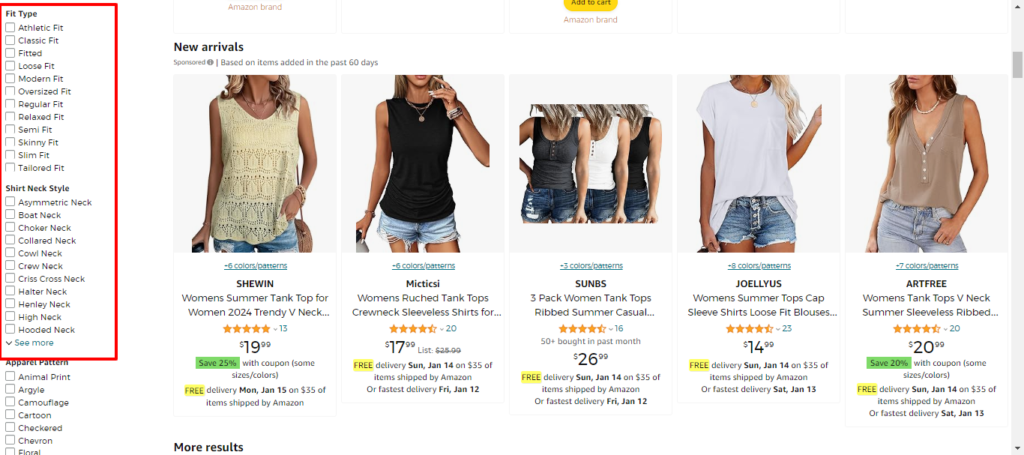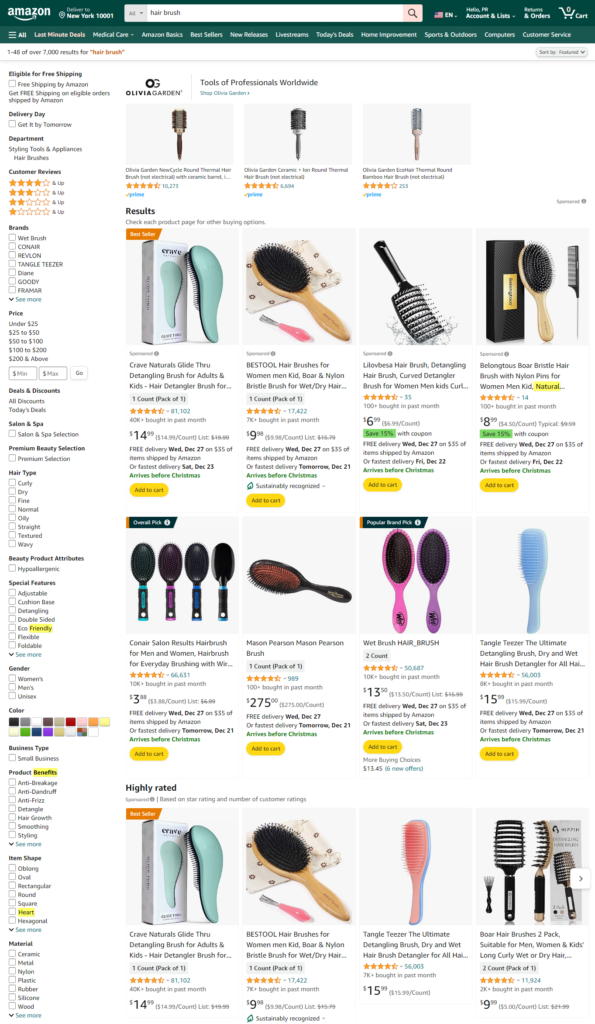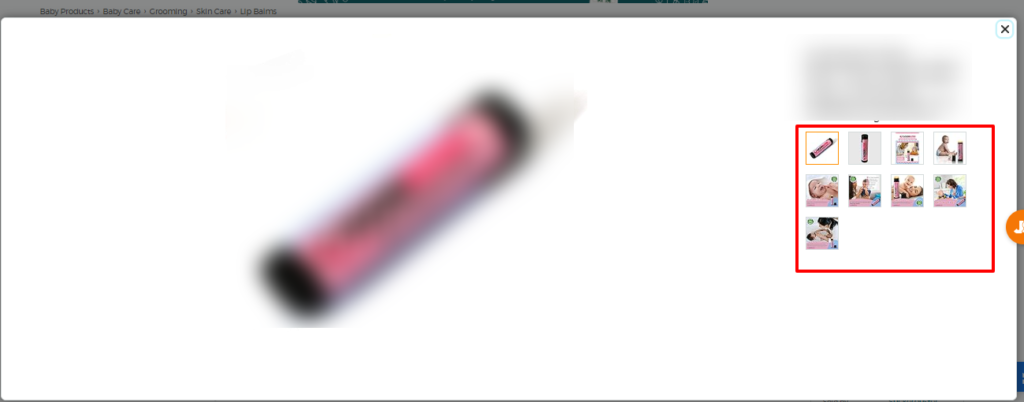
Achieving high product visibility for Amazon sellers is paramount, as online shoppers initiate product research on the platform. Amazon SEO is crucial for success, effectively influencing the ranking algorithm and connecting sellers with potential customers. Explore a detailed guide with insights and examples to enhance your product listings, ensuring effective optimization and improved customer connections in our post.
What Is Amazon SEO & Why Does It Matter?
Amazon SEO involves optimizing Amazon product listings for higher rankings in Amazon.com product searches and Amazon’s A9 ranking algorithm. This includes incorporating keywords in the product title, uploading high-quality photos, establishing competitive prices, and implementing other strategic optimizations. Implementing straightforward steps enhances search visibility, increases sales, and promotes brand discovery.
As an Amazon seller, use SEO strategies to:
- Enhance traffic to product listings
- Amplify product and brand visibility
- Elevate conversion rates and foster sales growth
Read More: Amazon SEO vs Google SEO
How Amazon SEO Works?
1. Amazon Search Box
Customers can discover items by entering a term or phrase into the search bar situated at the Amazon.com homepage’s top. This tool offers a swift product search through a dropdown menu of departments. Users can also input general keywords, and Amazon provides pertinent results, allowing customers to refine searches for specificity.
The best place to start when researching keywords is, without a doubt, the Amazon search box. Upon initiating a search query, the platform intelligently proposes pertinent and associated terms. By inputting your seed phrase, Amazon’s search function makes it easier to find related terms, simplifying the process of conducting thorough keyword research.

2. Amazon Search Filter
On the left-hand side, you’ll find filter fields offering a range of options, including product category, seller rating, shipment method, brand, color, product condition, and more. Amazon’s algorithms demonstrate intelligence by discerning product attributes, such as color, based on information present in the product listing copy.

3. Amazon Search Results Page
Amazon Seller Central uses a robust system for categorizing its products, and you can explore an in-depth guide to understand its functionalities better. When a user, buyer, or shopper searches Amazon, the results are displayed in two primary ways:
- List View: This layout showcases approximately 15 to 16 products on each result page.
- Gallery View: In this layout, around 24 to 25 products are presented on every result page.
This distinction is crucial for effectively categorizing products using these views and filters. Understanding how your product appears in these layouts aids in optimizing its visibility and presentation to potential customers.

Elements influencing search outcomes encompass:
- Product Titles
- Product Descriptions
- Optimized Images
- Product Features
- Competitive Pricing
Leverage SEO techniques to enhance each aspect and elevate your position in Amazon search rankings. Refer to the rest of this article for comprehensive insights.
4. Sponsored Products
Another crucial category in Amazon’s search results is Amazon Sponsored Products. These sponsored listings appear in various locations across different pages. Typically, sponsored product results are positioned at the top of a product page or may be integrated with organic results.
Optimizing sponsored product listings for Amazon SEO is essential in addition to employing effective keyword bidding strategies. By implementing the correct Amazon SEO tactics and strategically managing PPC campaigns, your product stands a better chance of securing a prominent position on the first page of Amazon sponsored products, enhancing its visibility and potential for sales.

Cost-per-click (CPC) ads and sponsored Products enable sellers with a Professional seller account and Amazon Brand Registry enrollment to promote specific product listings. These Amazon ads are displayed on shopping results pages and product detail pages and automatically matched to relevant shopping queries. Amazon Sponsored Products are a valuable tool to connect with high-intent shoppers actively seeking products akin to your listings.
5. Amazon Sales Rank
Amazon assigns a ranking to all sellers based on performance metrics, encompassing account health, customer reviews, product pricing, and various other factors. A higher sales rank typically indicates greater selling potential. To gain a comprehensive understanding of the sales rank system, it is recommended to delve into the intricacies of how it operates. Further insights on this can be found in Amazon’s guidelines on seller performance and ranking.

Optimize Your Amazon Listings In 6 Easy Steps
Consider SEO to be a continuous process that will assist you in engaging with Amazon’s 300 million customers. Start by incorporating optimization into your online eCommerce business plan. Below are the 7 important components of a product listing:
1. Conduct Thorough Keyword Research
Make a comprehensive keyword list. Keywords are the words and phrases that people look for while conducting an online search. Consider the items you sell and put yourself in the shoes of the buyer. What terms or phrases will people enter into the Amazon search box to find the products they are looking for?
When you look at sales from this angle, you’ll notice patterns. How can customers locate similar products to yours? Try the following ideas for keywords to integrate into your Amazon SEO strategy:
- Fill in the Amazon search box with a range of terms and phrases. Then, browse through the drop-down recommendations and begin developing a list of keywords for similar postings.
- Use competitor products to help you create your list of keywords already added by competitors. Experiment with similar Amazon.com searches to see what’s already available. After that, compare product search phrases.
- For more ideas, look through Amazon’s suggested and related item categories.
- Consider long-tail and short-tail keywords when you compile your list. Long-tail keywords are more specific. They usually have a low search volume, less competition, and a greater conversion rate because the customer understands exactly what they want. Short-tail keywords are broad searches with a high search volume and competition. They may have a lower conversion rate since the customer is looking at other possibilities.
2. Optimize Product Title
You only have a few seconds to capture a shopper’s attention. Amazon Product Title also known as Product Name is one of the key fields utilized by Amazon and search engines to determine the relevance of a detail page as part of a customer search. You can do a few things to boost the likelihood of a customer clicking on a title:
- Your Amazon product title should be the same as what appears on the actual packaging of your product.
- Take note of the various title lengths and suggested title styles for listings in each product category.
- Do not use all capital letters.
- Start the title with the product’s brand name
- Use digits instead of words: “2” instead of “two.”
- Use of non-language ASCII characters such as, or ® is not permitted.
- Titles should only include the information required to identify the object.
- Use of subjective remarks such as “Best Seller” or “Sale” is not permitted.
- Titles may contain essential punctuation such as hyphens (-), forward slashes (/), commas (,), ampersands (&), and periods (.
- Measurements such as “cm”, “oz”, “in”, and “kg” might be abbreviated in titles.
3. Optimize Product Key Features

Amazon Key features also known as Amazon product bullet points in layman’s language play an important factor in the relevance of a detail page as part of a customer search. Well-written bullet points will naturally contain keywords, but the priority should be to communicate clearly and help customers make a buying decision. One approach is to start a bullet point with a feature and then state the benefits of that feature.
Clear and concise Amazon bullet points are best. Use the below-mentioned guidelines as you write your bullet points:
- For each product, provide up to five bullet points.
- Each bullet point has a 500-character limit but don’t try to fill all 5 bullets to the maximum character limit. Try to be short yet explanative with the key points you want to explain about your product. This rule increases readability. Bullet points are not usually indexed by Amazon Search, but they are always displayed in their entirety on product detail pages.
- Highlight the five important qualities you want your customers to think about, such as dimensions, age appropriateness, optimal product conditions, skill level, contents, country of origin, and so on.
- Keep the same order for all products. Don’t change the pattern of writing the bullet in every product.
- Each bullet point should begin with a capital letter.
- Use sentence fragments and leave off the final punctuation.
- Include no promotional or pricing information.
- Make certain to adhere to all product detail page rules and restrictions.
4. Optimize Product Descriptions/ A+ Content

In your high-quality product descriptions include thorough information about product features and usage to help the customers in finding, evaluating, and purchasing things. You can additionally highlight unique product information that is not otherwise available in the listing.
Here are some additional pointers for writing high-quality Amazon product descriptions:
- Brand names should be included.
- Include measurements, such as shoe size, and clothing size, etc
- Include the sort of material, such as canvas for a rucksack.
- Include important information such as colors, packaging, and quantity
Keep in mind the best practices for listing quality in general, and consult the product listing standards for specific policies, rules, and limits. You should also carefully evaluate your products before declaring their condition. Check the condition guidelines for items that are unsuitable or prohibited.
If you are a brand owner then instead of adding descriptions to your listings, you should add Amazon A+ content to your products so that a customer can easily check every detail with the images added by you. When utilized properly, Amazon A+ Content allows the brand owners to convey product characteristics in new ways by using a distinctive brand story, enhanced photos, and text placements, which may result in higher conversion rates, more traffic, and increased sales.
5. Optimize Product Images

Customers can visually examine and compare crucial aspects when they use high-quality photos. Multiple photographs allow customers to view the goods from various perspectives and can influence a buyer to choose one search result over another. Amazon Product photos that are effective capture a customer’s imagination and inspire them to make a buy. Product Images should show the product in use, show various angles, and highlight different features.
Here are a few important points to keep in mind regarding product images:
- At least one product image is required for each detail page. Six photos and one video are sufficient.
- Images should be clear, informative, and visually appealing.
- Images must have a white background and take up at least 85% of the available image area.
- To improve the quality of your listing, use 1000 x 1,000 pixels.
- In terms of size, color, and accuracy, the image fits the product description.
- The product is easily identified.
- The image is a photograph rather than a drawing.
- The product is well-lit and focused.
- Highlights and shadows do not obscure close-up images.
- The image depicts the full product.
- Backgrounds are kept simple and tidy to avoid drawing attention away from the product.
- As many distinct photos as possible should be provided. Swatch pictures and alternate images are allowed in several product categories.
- Additionally, ensure that all product image criteria are met. Photos you post must also meet technical file specifications. If you encounter difficulty, look into image issues and image troubleshooting.
- Download the Image Style Guide if you sell apparel to check requirements across product categories, and understand the dos and don’ts.
6. Optimize Product Search Terms
Backend keywords allow you to produce engaging and accessible text for a product page while ensuring that Amazon crawls all keywords important to the product. Because shoppers do not see these keywords, adding them to the “backend” of product listings improves product discoverability.
Tips for Improving Your Search Terms
- Include just generic words.
- Include synonyms, acronyms, and alternative product names.
- Keep your length under control. Because you only have 249 characters. Spaces and punctuation are not allowed. Learn more about keyword properties, limitations, and alternatives.
- When entering phrases, enter them in a reasonable search sequence.
- Include spelling variations if applicable, but avoid using frequent misspellings.
- Abbreviations and alternate names should be included.
- All lowercase letters are permitted.
- You don’t need any punctuation, so leave out the hyphens (-), colons (:), and so on.
- Only use spaces to separate words.
- Don’t use the same words twice in the Search Terms field.
- There’s no need for terms like “a,” “an,” “and,” “by,” “for,” “of,” “the,” “with,” and so forth.
- There is no need to use both the singular and plural.
Read More: Actionable Tips to Improve your Local SEO
Best Amazon SEO Best Practices
1. Don’t Repeat Keywords
Concentrate on offering a pleasant customer experience. Write organically and provide them with the information they need to make a purchasing decision. Keyword repetition/ keyword stuffing can be harmful and ineffective.
2. Check The Old Customer Questions
On your product page, respond to prior seller questions and product inquiries. Try to anticipate and focus on what your customer wants to know about a product rather than what you want to say about it.
3. Help Improve Your Rankings
If you are shipping on your own then providing fast delivery times helps to improve rankings. Enroll in Brand Registry to use A+ Content. To qualify for the Prime badge and fast, free shipping, become an Amazon Prime seller, which is included when you enroll in FBA. Customers who routinely search for products with the Prime logo may benefit from this.
4. Use These Basic Tips For Listings
Be descriptive while remaining clear and to the point. Be accurate and genuine about the condition and quality of the product. Avoid making subjective claims.
Conclusion
Correctly optimizing your product listing will increase your product’s appeal and discoverability by up to 80%. However, the process does not finish there. To remain in the top results, you must keep up with trends, algorithm updates, and constant optimization. Amazon SEO is very essential for selling on Amazon. If you don’t optimize your listings for SEO, you will struggle to sell products and get sales. That’s why it’s critical to either learn how to rank on Amazon or hire an Amazon SEO agency for Amazon like us who does it.
At SIPRANSH ECOMMGROWTH, we’re an experienced Amazon SEO agency, having helped our clients manage product listing optimizations that help buyers into their customers. When you partner with our talented team, you can trust we’ll help your Amazon Store thrive.






